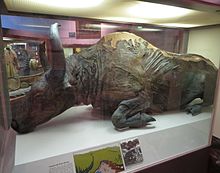ไบซันทุ่งหญ้าสเตปป์
| ไบซันทุ่งหญ้าสเตปป์ ช่วงเวลาที่มีชีวิตอยู่: Irvingtonian to Holocene 1.8–0.005Ma | |
|---|---|

| |
| "Blue Babe", a mummified specimen from Alaska | |
| การจำแนกชั้นทางวิทยาศาสตร์ | |
| ขาดข้อมูล (กรุณาคัดลอกจากหน้านี้ในวิกิพีเดียภาษาอังกฤษ มาที่หน้านี้): ขาดแม่แบบอนุกรมวิธาน ทำตามขั้นตอนด้านบนเพื่อสร้าง |
Theria/skip |
| อันดับ: | สัตว์กีบคู่ |
| วงศ์: | วงศ์วัวและควาย |
| วงศ์ย่อย: | วงศ์ย่อยวัวและควาย |
| สกุล: | Bison Bojanus, 1827 |
| สปีชีส์: | †Bison priscus |
| ชื่อทวินาม | |
| †Bison priscus Bojanus, 1827 | |
ไบซันทุ่งหญ้าสเตปป์ (Bison priscus)[1] (อังกฤษ: steppe bison, steppe wisent) เป็นสปีชีส์ไบซันที่สูญพันธุ์ไปแล้ว ครั้งหนึ่งเคยพบในแมมมอธสเตปป์ (mammoth steppe) ที่มีอาณาบริเวณครอบคลุมบริติชไอลส์[2] ยุโรป[3], เอเชียกลาง[4], ทางเหนือไปจนถึงตะวันออกเฉียงเหนือของเอเชีย[5][6][7][8], เบอริงเจีย และอเมริกาเหนือ[9][10], จากตะวันตกเฉียงเหนือของแคนาดาถึงเม็กซิโกในยุคควอเทอร์นารี การกระจายอย่างกว้างขวางนี้บางครั้งเรียกว่า ไบซันยุคไพลสโตซีนเทียบกับไบซันใหญ่[11] จากการหาอายุจากคาร์บอนกัมมันตรังสีจากโครงกระดูกของไบซันทุ่งหญ้าสเตปป์ระบุว่าพวกมันมีชีวิตอยู่เมื่อ 5,400 ปีก่อนในอะแลสกา[12] เรดิโอคาร์บอนสืบมาของโครงกระดูกไบซันทุ่งหญ้าสเตปป์บ่งชี้ว่ามีอยู่เมื่อ 5,400 ปีก่อนในอลาสก้า.[13] มีการเสนอสปีชีส์ย่อยตามกาลเวลาสามสปีชีส์ ได้แก่ Bison priscus priscus, Bison priscus mediator, และ Bison priscus gigas[14]
วิวัฒนาการ[แก้]

เชื่อกันว่าไบซันทุ่งหญ้าสเตปป์มีวิวัฒนาการมาจาก Bison paleosinensis ในเอเชียใต้ ซึ่งหมายความว่าสายพันธุ์นี้ปรากฏขึ้นในเวลาและที่ภูมิภาคใกล้เคียงกันกับออรอช (auroch, Bos primigenius) ซึ่งในบางคร้งอาจเกิดความสับสนเกี่ยวกับลูกหลานของพวกมัน ในช่วงท้าย ๆ ไบซันทุ่งหญ้าสเตปป์อาศัยร่วมช่วงเวลากับควายไบซันป่าไพลสโตซีน (B. schoetensacki) และ ควายไบซันยุโรป (Bison bonasus), Bison hanaizumiensis ในญี่ปุ่น[5][6], และควายไบซันเขายาว (Bison latifrons) ในอเมริกาเหนือ
ไบซันทุ่งหญ้าสเตปป์สูญพันธุ์ไปในช่วงกลางถึงปลายสมัยโฮโลซีน เนื่องจากถูกแทนที่ด้วยไบซันยุโรปสมัยใหม่ (B. bonasus) ในปี ค.ศ. 2016 เคยมีความเชื่อว่าไบซันชนิดนี้เป็นลูกผสมระหว่าง B. priscus และ Bos primigenius[15] ซึ่งเป็นข้อสรุปก่อนก่อนเวลาอันสมควรที่มีพื้นฐานมาจากการเรียงลำดับเชื้อสายที่ไม่สมบูรณ์[16], และในอเมริกาโดยลำดับดีเอ็นเอของหลายสปีชีส์ (เช่น Bison antiquus และ Bison occidentalis) ซึ่งมีสืบมาจนถึงไบซันอเมริกันสมัยใหม่ (Bison bison)[17] ภาพวาดบนผนังถ้ำในยุโรปปรากฏทั้ง B. bonasus และ B. priscus[18]
ไบซันทุ่งหญ้าสเตปป์คล้ายกับควายไบซันสมัยใหม่โดยเฉพาะไบซันป่าอเมริกัน (Bison bison athabascae)[19] ไบซันทุ่งหญ้าสเตปป์มีความสูงมากกว่า 2 ม. เมื่อวัดถึงตะโหงก มีน้ำหนักได้ถึง 900 กก. (2,000 ปอนด์) ปลายเขาอยู่ห่างกันหนึ่งเมตร[20] ตัวเขามีความยาวมากกว่าครึ่งเมตร

ไบซันทุ่งหญ้าสเตปป์ปรากฏในศิลปะบนผนังถ้ำโดยเฉพาะในถ้ำอัลตามิราและถ้ำลัสโก, รูปแกะสลัก Bison Licking Insect Bite, และพบในรูปแบบที่ถูกเก็บรักษาตามธรรมชาติด้วยน้ำแข็ง[17][21][22]
บลูเบ๊บ (Blue Babe) เป็นมัมมี่อายุ 36,000 ปีของไบซันทุ่งหญ้าสเตปป์ตัวผู้ ซึ่งถูกค้นพบทางตอนเหนือของแฟร์แบงคส์, อะแลสกา ในเดือนกรกฎาคม ค.ศ. 1979[23] คนงานเหมืองทองสังเกตเห็นมัมมี่และตั้งชื่อว่าบลูเบ๊บ - "เบ๊บ" มาจากวัวยักษ์ในตำนานของพอลบันยัน ที่เปลี่ยนเป็นสีน้ำเงินไปตลอดกาลหลังจากที่ถูกฝังท่วมเขาท่ามกลางพายุหิมะ (สีน้ำเงินของบลูเบ๊บเกิดจากชั้นเคลือบของวิเวียนไนต์ ซึ่งเป็นเหล็กฟอสเฟตสีน้ำเงินที่ปกคลุมตัวมมัมมี่ไว้)[1] นอกจากนี้บลูเบ๊บยังถูกอ้างถึงบ่อยครั้งเมื่อพูดถึงนักวิทยาศาสตร์ที่กินตัวอย่างของตัวเอง มีที่มาจากการที่ทีมวิจัยเตรียมที่มัมมี่สำหรับการจัดแสดงถาวรในพิพิธภัณฑ์ University of Alaska นำส่วนหนึ่งของคอมัมมี่ออกมาตุ๋นรับประทานเพื่อเฉลิมฉลองความสำเร็จ[24][25]
ในปี ค.ศ. 2011 มีการพบมัมมี่อายุ 9,300 ปีที่ Yukagir ในไซบีเรีย[26]
ความพยายามที่จะคืนชีพ[แก้]
ทีมนักวิทยาศาสตร์ชาวรัสเซียและเกาหลีเสนอให้มีการฟื้นคืนชีพไบซันทุ่งหญ้าสเตปป์ด้วยไบซันป่าในไซบีเรียโดยใช้เทคนิคการโคลนนิง โดยเฉพาะอย่างยิ่งกับฝูงที่นำกลับเข้ามาใหม่ในยาคูเตีย ประเทศรัสเซีย[27]
อ้างอิง[แก้]
- ↑ 1.0 1.1 "Steppe Bison" เก็บถาวร 2010-12-12 ที่ เวย์แบ็กแมชชีน – Yukon Beringia Interpretive Centre. Beringia.com. Retrieved on 2013-05-31.
- ↑ "Kirkdale Cave (Pleistocene of the United Kingdom)". คลังข้อมูลเก่าเก็บจากแหล่งเดิมเมื่อ 2021-02-28. สืบค้นเมื่อ 2020-11-21.
- ↑ Вестник Кирилло-Белозерского музея 9 (Май 2006) О. Яшина, Т.В. Цветкова – Кирилловский бизон. Kirmuseum.ru. Retrieved on 2013-05-31.
- ↑ Vasiliev, S. K. (2008). "Late pleistocene bison (Bison p. priscus Bojanis, 1827) from the Southeastern part of Western Siberia". Archaeology, Ethnology and Anthropology of Eurasia. 34 (2): 34–56. doi:10.1016/j.aeae.2008.07.004.
- ↑ 5.0 5.1 Kurosawa, Y. "モノが語る牛と人間の文化 - ② 岩手の牛たち" (PDF). LIAJ News (109): 29–31. สืบค้นเมื่อ 2016-04-06.
- ↑ 6.0 6.1 Hasegawa, Y.; Okumura, Y.; Tatsukawa, H. (2009). "First record of Late Pleistocene Bison from the fissure deposits of the Kuzuu Limestone, Yamasuge,Sano-shi,Tochigi Prefecture,Japan" (PDF). Bull.Gunma Mus.Natu.Hist. (13): 47–52. สืบค้นเมื่อ 2018-12-03.
- ↑ Boeskorov, Gennady G.; Potapova, Olga R.; Protopopov, Albert V.; Plotnikov, Valery V.; Agenbroad, Larry D.; Kirikov, Konstantin S.; Pavlov, Innokenty S.; Shchelchkova, Marina V.; Belolyubskii, Innocenty N.; Tomshin, Mikhail D.; Kowalczyk, Rafal; Davydov, Sergey P.; Kolesov, Stanislav D.; Tikhonov, Alexey N.; Van Der Plicht, Johannes (2016). "The Yukagir Bison: The exterior morphology of a complete frozen mummy of the extinct steppe bison, Bison priscus from the early Holocene of northern Yakutia, Russia". Quaternary International. 406: 94–110. Bibcode:2016QuInt.406...94B. doi:10.1016/j.quaint.2015.11.084.
- ↑ Yeong-Seok Jo, John T. Baccus, John Koprowski, 2018, Mammals of Korea, p.30, National Institute of Biological Resources of Korea
- ↑ Zazula, Grant D.; MacKay, Glen; Andrews, Thomas D.; Shapiro, Beth; Letts, Brandon; Broc, Fiona (2009). "A late Pleistocene steppe bison (Bison priscus) partial carcass from Tsiigehtchic, Northwest Territories, Canada". Quaternary Science Reviews. 28 (25–26): 2734–2742. Bibcode:2009QSRv...28.2734Z. doi:10.1016/j.quascirev.2009.06.012.
- ↑ Marsolier-Kergoat, Marie-Claude; Palacio, Pauline; Berthonaud, Véronique; Maksud, Frédéric; Stafford, Thomas; Bégouën, Robert; Elalouf, Jean-Marc (2015-06-17). "Hunting the Extinct Steppe Bison (Bison priscus) Mitochondrial Genome in the Trois-Frères Paleolithic Painted Cave". PLOS ONE. 10 (6): e0128267. Bibcode:2015PLoSO..1028267M. doi:10.1371/journal.pone.0128267. ISSN 1932-6203. PMC 4471230. PMID 26083419.
- ↑ Hunting the Extinct Steppe Bison (Bison priscus) Mitochondrial Genome in the Trois-Frères Paleolithic Painted Cave
- ↑ Hunting the Extinct Steppe Bison (Bison priscus) Mitochondrial Genome in the Trois-Frères Paleolithic Painted Cave
- ↑ Zazula, Grant D.; Hall, Elizabeth; Hare, P. Gregory; Thomas, Christian; Mathewes, Rolf; La Farge, Catherine; Martel, André L.; Heintzman, Peter D.; Shapiro, Beth (2017). "A middle Holocene steppe bison and paleoenvironments from the Versleuce Meadows, Whitehorse, Yukon, Canada" (PDF). Canadian Journal of Earth Sciences. 54 (11): 1138–1152. Bibcode:2017CaJES..54.1138Z. doi:10.1139/cjes-2017-0100. hdl:1807/78639.
- ↑ Castaños, J.; Castaños, P.; Murelaga, X. (2016). "First Complete Skull of a Late Pleistocene Steppe Bison ( Bison priscus ) in the Iberian Peninsula". Ameghiniana. 53 (5): 543–551. doi:10.5710/AMGH.03.06.2016.2995. S2CID 132682791.
- ↑ Soubrier, J.; Gower, G.; และคณะ (2016). "Early cave art and ancient DNA record the origin of European bison". Nature Communications. 7: 13158. Bibcode:2016NatCo...713158S. doi:10.1038/ncomms13158. PMC 5071849. PMID 27754477.
- ↑ Wang, Kun; Lenstra, Johannes A.; และคณะ (2018). "Incomplete lineage sorting rather than hybridization explains the inconsistent phylogeny of the wisent". Communications Biology. 1: 13158. doi:10.1038/s42003-018-0176-6. PMC 6195592. PMID 30374461.
- ↑ 17.0 17.1 Verkaar, E. L. C.; Nijman, IJ; Beeke, M.; Hanekamp, E.; Lenstra, J. A. (2004). "Maternal and Paternal Lineages in Cross-Breeding Bovine Species. Has Wisent a Hybrid Origin?". Molecular Biology and Evolution. 21 (7): 1165–70. doi:10.1093/molbev/msh064. PMID 14739241.
- ↑ Briggs, H. (19 October 2016). "Cave paintings reveal clues to mystery Ice Age beast". BBC.com. สืบค้นเมื่อ 2016-10-19.
- ↑ Boeskorov, Gennady G.; Potapova, Olga R.; และคณะ (25 June 2016). "The Yukagir Bison: The exterior morphology of a complete frozen mummy of the extinct steppe bison, Bison priscus from the early Holocene of northern Yakutia, Russia". Quaternary International. 406: 94–110. Bibcode:2016QuInt.406...94B. doi:10.1016/j.quaint.2015.11.084.
- ↑ McPhee, R. D. E. (1999). Extinctions in Near Time: Causes, Contexts, and Consequences. Springer. p. 262. ISBN 978-0306460920.
- ↑ Dale Guthrie, R (1989). Frozen Fauna of the Mammoth Steppe: The Story of Blue Babe. ISBN 9780226311234.
- ↑ Paglia, C. (2004). "The Magic of Images: Word and Picture in a Media Age". Arion: A Journal of Humanities and the Classics. 11 (3): 1–22. JSTOR 20163935.
- ↑ Deem, James M. "Blue Babe - the 36,000 year-old male bison"[ลิงก์เสีย] James M. Deem's Mummy Tombs. 1988-2012. Accessed 20 March 2012.
- ↑ Dale Guthrie, R (1989). Frozen Fauna of the Mammoth Steppe: The Story of Blue Babe. p. 298. ISBN 9780226311234.
- ↑ ḎḤWTY. "Blue Babe: Would You Eat 36,000-year-old Bison Meat?". Ancient Origins (ภาษาอังกฤษ). สืบค้นเมื่อ 8 April 2018.
- ↑ Palermo, Elizabeth (6 November 2014). "9,000-Year-Old Bison Mummy Found Frozen in Time". www.livescience.com. สืบค้นเมื่อ 4 December 2014.
- ↑ Cloning ancient extinct bison sounds like sci-fi, but scientists hope to succeed within years
